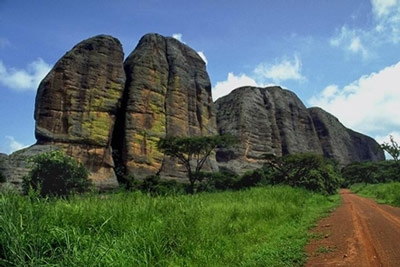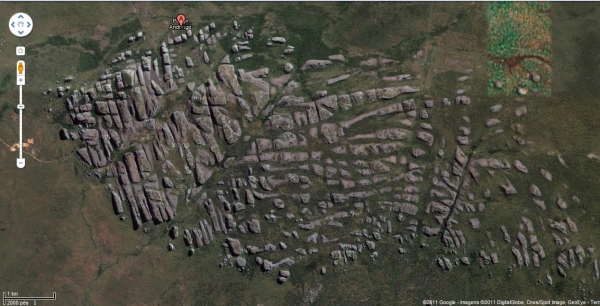As pedras negras
de Pungo Andongo
 As pedras negras do Pungo
Andongo são uma das mais famosas feições geomorfológicas de Angola,
situando-se perto da estrada que liga Malange a Luanda. Estas
estranhas formações geológicas (algumas com formas bastante
sugestivas), são constituídas por conglomerados graníticos e têm
uma forma colunar ou de domos arredondados.
As pedras negras do Pungo
Andongo são uma das mais famosas feições geomorfológicas de Angola,
situando-se perto da estrada que liga Malange a Luanda. Estas
estranhas formações geológicas (algumas com formas bastante
sugestivas), são constituídas por conglomerados graníticos e têm
uma forma colunar ou de domos arredondados.
É sem surpresa que a estas feições está
associada uma mitologia própria, associada a figuras históricas
angolanas. A vila de Pungo-Andongo localiza-se nas imediações, bem
como as ruínas da antiga Fortaleza de Pungo-Andongo, erguida pelos
portugueses em 1671.
As Quedas de Kalandula (rio Lucala) localizam-se
relativamente perto e merecem os quilómetros adicionais. Com 105
metros de altura, são as segundas mais altas de África (EARTHCACHE
a publicar em breve).
As pedras negras do Pungo Andongo são resultado
de processos erosivos desenvolvidos ao longo dos planos estruturais
de fraqueza de conglomerados graníticos antigos (ver imagem de
satélite obtida no Google Earth); as colunas e os domos
arredondados são os núcleos resistentes remanescentes. Água mole em
pedra dura tanto dá até que fura; sim, a água e o tempo acabarão
por destruir completamente estas rochas, no ciclo geológico de
destruição das rochas antigas e criação de novas rochas; no
entanto, estes gigantes de pedra resistirão de pé, para espanto e
prazer dos viajantes mais aventurosos.
Os conglomerados são rochas de origem sedimentar
formadas por clastos (fragmentos) arredondados de rochas
preexistentes, na maioria, de tamanho superior a um grão de areia
(acima de 2 mm na classificação de Wentworth), unidos por um
cimento de material calcário, óxido de ferro, sílica ou argila.
Os conglomerados do Pungo Andongo ilustram
também o ciclo geológico de contínua destruição e criação de
rochas: o conglomerado que constitui estas rochas, originado em
processos sedimentares inclui clastos de granito (gerado em ciclos
geológicos anteriores). Para logar esta Earthcache, diga-me apenas
a dimensão dos clastos de granito presentes nos conglomerados
(entre que diâmetros variam). Como opção, inclua uma foto do local
no seu log (escolha a melhor, vai tirar muitas fotos).
Pungo Andongo
black stones
The Pungo Andongo black stones, located just
next to the Luanda – Malange road, is one of the most famous
Angolan landmarks. These strange geological formations (granitic
conglomerates is their nature) have a columnar shape; they are a
phalanx of giant stones.

Unsurprisingly, these remarkable stones are
associated to several myths involving historical characters. These
formations are located next to the Pungo Andongo village, as well
as the XVII century Portuguese fort. The Kalandula Falls are
relatively nearby; they are worth a trip (look out for the
forthcoming Earthcache).
The Pungo Andongo landform is result of erosion
processes along the original formation structural weakness planes
(see satellite picture from Google Earth); the columns and rounded
ridges are the strongest nuclei of the granitic conglomerates. Yes,
time and water will eventually complete their toll on even the
strongest of rocks; meanwhile these black stone giants will awe the
adventurous travelers.
A conglomerate is a rock consisting of
individual clasts within a finer-grained matrix that have become
cemented together. Conglomerates are sedimentary rocks consisting
of rounded fragments and are thus differentiated from breccias,
which consist of angular clasts. Both conglomerates and breccias
are characterized by clasts larger than sand (>2 mm).
The Pungo Andongo conglomerates are also an
illustration of the never ending geological processes; a formation
with sedimentary origin these stones incorporate granitic clasts
(of previous stone generation cycles). To log this Earthcache, you
will have to tell me the size of these conglomerate’s
granitic clasts (the minimum and maximum diameters of the
elements). As an option, add your best picture to your log (yes,
you will take plenty of photos; this landform calls for it).
